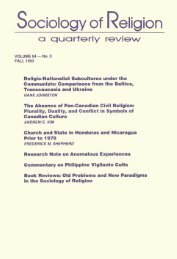The Sources of Gender Role Attitudes among Christian and Muslim ...
The Sources of Gender Role Attitudes among Christian and Muslim ...
The Sources of Gender Role Attitudes among Christian and Muslim ...
Create successful ePaper yourself
Turn your PDF publications into a flip-book with our unique Google optimized e-Paper software.
208 SOCIOLOGY OF RELIGION<br />
striking because Arab Americans are diverse in their affiliations as <strong>Christian</strong>s<br />
<strong>and</strong> <strong>Muslim</strong>s, which <strong>of</strong>fers an ideal opportunity to compare the influences <strong>of</strong><br />
Islam <strong>and</strong> <strong>Christian</strong>ity on women's attitudes <strong>and</strong> behaviors.<br />
Cultural stereotypes <strong>of</strong> Amb-American women tend to collapse religion <strong>and</strong><br />
ethnicity into synonymous components <strong>of</strong> culture, portraying them as veiled<br />
Islamic traditionalists (Shakir 1997; Suleiman 1999; Terry 1985). However,<br />
there are numerous reasons to believe that cultural influences on Arab-<br />
American women's attitudes are more complicated than these images would<br />
suggest. On the one h<strong>and</strong>, Arab Americans as a group ate more highly educated,<br />
have higher labor force participation rates, <strong>and</strong> earn higher incomes than the<br />
U.S. adult population, aU <strong>of</strong> which suggest an assimilated <strong>and</strong> progressive ethnic<br />
population (Samhan 2001; U.S. Bureau <strong>of</strong> the Census 1990). On the other<br />
h<strong>and</strong>, Arab cultural <strong>and</strong> religious customs reinforce traditional gender roles,<br />
especially those regarding women's responsibilities in the home <strong>and</strong> family<br />
(Bilge <strong>and</strong> Aswad 1996; Haddad <strong>and</strong> Smith 1996).<br />
This research constitutes the first national study <strong>of</strong> Arab-American women<br />
<strong>and</strong> aims to distinguish religious <strong>and</strong> ethnic influences on women's gender tole<br />
attitudes. Using national survey data collected from 501 Arab-American<br />
women, this study examines the impact <strong>of</strong> <strong>Muslim</strong> affiliation, Arab ethnicity,<br />
<strong>and</strong> religiosity on women's degree <strong>of</strong> gender traditionalism. Prior research flnds<br />
that religious affiliation, religiosity, <strong>and</strong> ethnicity can have complicated <strong>and</strong><br />
contradictory effects on women's attitudes <strong>and</strong> behaviors (e.g., Lehrer 1995;<br />
Wilder <strong>and</strong> Walters 1998). <strong>The</strong> current study aims to extend this literature to a<br />
lesser-known population <strong>of</strong> Arab-American women.<br />
BACKGROUND<br />
Ah extensive body <strong>of</strong> research on Judeo-<strong>Christian</strong> influences finds a strong<br />
association between fundamentalist affiliation <strong>and</strong> participation <strong>and</strong> inegali-<br />
ta¡ gender tole attitudes (Bartkowski 1999, 2001; Bartkowski <strong>and</strong> Read 2003;<br />
Beaman 2001; Heaton <strong>and</strong> Cornwall 1989; Lehrer 1995; Peek, Lowe, <strong>and</strong><br />
Williams 1991; Read <strong>and</strong> Bartkowski 2000; Sherkat 2000; Wilcox <strong>and</strong> Jelen<br />
1991). Women who belong to <strong>and</strong> participate in orthodox Jewish <strong>and</strong> conser-<br />
vative <strong>Christian</strong> denominations, where issues regarding the family <strong>and</strong> gender<br />
roles ate particularly important, hold more traditional gender tole attitudes than<br />
women who belong to more moderate denominations <strong>of</strong> who have no religious<br />
affiliation (Hardacre 1997; Peek et al. 1991).<br />
Explanations for these variations highlight the importance <strong>of</strong> religion in<br />
promoting <strong>and</strong> maintaining subcultural differences in social attitudes, especially<br />
on issues that are salient to the group (Hertel <strong>and</strong> Hughes 1987; Gay, Ellison,<br />
<strong>and</strong> Powers 1996). Family <strong>and</strong> gender relations are <strong>among</strong> the most important<br />
for aU major religious traditions, <strong>and</strong> there has been extensive attention paid to<br />
denominational variations on these decisive issues (e.g., Bartkowski 2001;<br />
Downloaded from<br />
http://socrel.oxfordjournals.org/<br />
by guest on January 18, 2013



